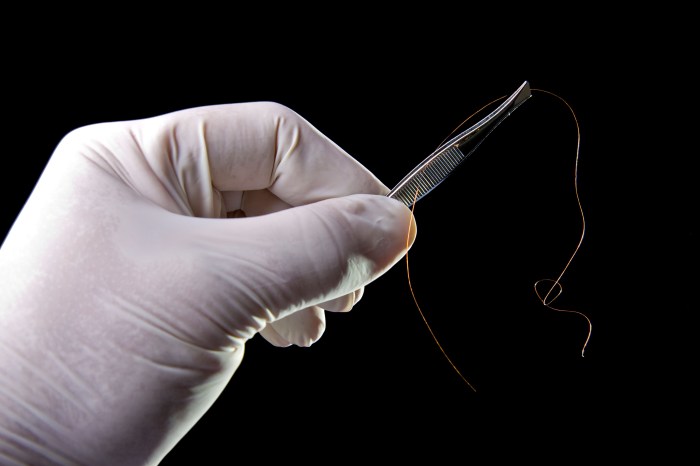A single strand of hair is enough to construct an image of criminals face – a statement that sounds like something out of a sci-fi movie, but it’s quickly becoming a reality thanks to the advancements in DNA analysis. This groundbreaking technology allows scientists to extract genetic information from a single hair, and use it to predict facial features with surprising accuracy.
The process involves analyzing specific genetic markers that influence facial characteristics like eye color, nose shape, and jawline. While this technology holds immense potential for solving crimes and identifying missing persons, it also raises ethical concerns about privacy and potential misuse. This article delves into the science behind DNA-based facial reconstruction, exploring its applications, limitations, and the ethical considerations surrounding its use.
The Science Behind DNA Analysis
The field of DNA analysis has revolutionized forensic science, allowing investigators to identify individuals with remarkable accuracy. This technique, based on the unique genetic blueprint of each person, has become an indispensable tool in solving crimes and establishing paternity. One of the most remarkable aspects of DNA analysis is its ability to extract valuable information from even the smallest traces of biological evidence, such as a single strand of hair.
Extracting DNA from a Single Strand of Hair
Extracting DNA from a single strand of hair involves a meticulous process that utilizes specialized techniques to isolate the genetic material. The process begins by carefully separating the hair shaft from the root, as the root contains the most DNA. The hair shaft is then treated with chemicals to break down the protective layers, exposing the DNA within. After this, the DNA is carefully extracted and purified, ensuring that it is free from contaminants.
DNA Analysis Techniques for Identification
DNA analysis techniques employed for identification are based on the variations in the genetic code between individuals. These techniques can be broadly categorized into two main types:
- Restriction Fragment Length Polymorphism (RFLP): This technique involves cutting DNA with specific enzymes called restriction enzymes, generating fragments of varying lengths. These fragments are then separated by size using gel electrophoresis, creating a unique pattern that can be used for identification.
- Polymerase Chain Reaction (PCR): This technique amplifies specific regions of DNA, known as Short Tandem Repeats (STRs), which are highly variable between individuals. These amplified STRs are then analyzed using electrophoresis and compared to known DNA profiles, allowing for accurate identification.
Accuracy and Limitations of DNA Analysis Methods, A single strand of hair is enough to construct an image of criminals face
DNA analysis techniques have proven to be incredibly accurate, providing a high degree of certainty in identification. However, it is important to understand that no method is foolproof and certain limitations exist:
- Contamination: DNA analysis can be compromised by contamination from other sources, such as the investigator’s DNA or environmental factors. This can lead to false-positive results, requiring stringent protocols to minimize contamination.
- Database Size: The accuracy of DNA analysis depends heavily on the size and quality of the DNA database used for comparison. A larger database increases the chances of finding a match, while a smaller database may limit the identification potential.
- Degraded DNA: DNA can degrade over time, especially in harsh environments. This can make analysis difficult or impossible, as the degraded DNA may not be sufficient for accurate identification.
Ethical and Legal Implications
The ability to reconstruct a person’s face from a single strand of hair raises significant ethical and legal concerns. While this technology has the potential to aid in criminal investigations and identify missing persons, it also presents a range of potential pitfalls and challenges that must be carefully considered.
Privacy Concerns
The use of DNA for facial reconstruction raises serious privacy concerns. The process involves accessing and analyzing an individual’s genetic information, which can reveal sensitive details about their ancestry, health, and even their susceptibility to certain diseases. This information could be misused or abused, leading to discrimination, social stigma, or even genetic profiling. For instance, a person’s genetic information could be used to deny them insurance coverage or employment opportunities.
Potential for Misuse and Abuse
The technology could be misused or abused by law enforcement agencies or private entities. For example, it could be used to create facial reconstructions of individuals who have not been accused of any crime, potentially leading to false accusations or wrongful arrests. Additionally, the technology could be used to create “deepfakes,” or realistic-looking synthetic images of individuals that could be used for malicious purposes, such as defamation or blackmail.
Legal Framework for DNA Evidence
The legal framework governing the collection and analysis of DNA evidence varies from country to country. In many jurisdictions, the use of DNA evidence is strictly regulated, with legal safeguards in place to protect individual rights. However, the rapid advancements in DNA technology, including facial reconstruction, pose new challenges for legal systems. For example, the legal definition of “evidence” may need to be redefined to encompass the use of DNA-based facial reconstructions.
Ethical Considerations
The use of DNA for facial reconstruction raises fundamental ethical questions. For instance, is it ethical to create a facial reconstruction of a person without their consent, even if it is for a legitimate law enforcement purpose? Additionally, there are concerns about the potential for bias in facial reconstruction algorithms, which could lead to inaccurate or discriminatory results.
Need for Regulation and Oversight
Given the potential risks associated with DNA-based facial reconstruction, there is a clear need for regulation and oversight of this technology. This could involve establishing clear legal guidelines for the collection, analysis, and use of DNA for facial reconstruction, as well as developing ethical frameworks to ensure that the technology is used responsibly.
Future Directions and Developments: A Single Strand Of Hair Is Enough To Construct An Image Of Criminals Face
The field of DNA analysis and facial reconstruction is constantly evolving, driven by advancements in technology and research. These developments promise to refine our understanding of human biology and improve the accuracy and efficiency of forensic investigations.
Advancements in DNA Analysis and Facial Reconstruction Techniques
The future holds exciting possibilities for improving the accuracy and resolution of facial reconstructions based on DNA. Current techniques are limited by the availability of DNA data and the complexity of the genetic code. Researchers are exploring ways to enhance these techniques by:
- Developing more sophisticated algorithms that can better predict facial features from DNA data.
- Expanding the database of DNA samples and facial images to improve the accuracy of predictions.
- Integrating other genetic markers, such as those related to skin color, eye color, and hair texture, to create more comprehensive reconstructions.
These advancements have the potential to revolutionize forensic investigations, allowing investigators to generate more accurate and detailed facial reconstructions from limited DNA evidence.
The Impact of Artificial Intelligence
Artificial intelligence (AI) is poised to play a significant role in the future of DNA analysis and facial reconstruction. AI algorithms can be trained on vast datasets of DNA and facial images to identify complex patterns and relationships. This can lead to:
- Improved accuracy in predicting facial features from DNA data.
- Enhanced speed and efficiency in processing DNA samples and generating facial reconstructions.
- Development of new techniques for reconstructing faces from degraded or incomplete DNA samples.
AI-powered tools are expected to significantly enhance the capabilities of forensic scientists and law enforcement agencies, leading to faster and more effective investigations.
The ability to reconstruct a face from a single strand of hair is a testament to the power of science and the rapid pace of technological advancements. While this technology holds immense potential for solving crimes and identifying missing persons, it’s crucial to address the ethical implications and ensure responsible use. As we move forward, it’s vital to strike a balance between harnessing the power of this technology and safeguarding individual rights and privacy.
Imagine a world where a single strand of hair is enough to construct an image of a criminal’s face. Sounds like a scene from a sci-fi thriller, right? Well, it might not be that far-fetched anymore, especially with the advancements in technology. And while we’re on the topic of advancements, Sony has renewed the PlayStation Powers series for a second season , which promises even more mind-blowing visuals and innovative storytelling.
So, who knows, maybe that single strand of hair will be used to solve a case in a future episode, bringing the real world and the fictional one a little closer.
 Standi Techno News
Standi Techno News

